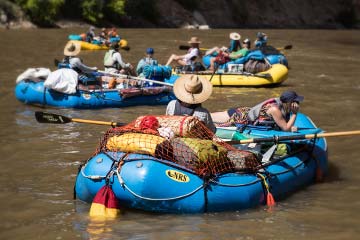New US Coast Guard PFD Approval System
In 2014, the Coast Guard announced the final rule to change the way PFDs are labeled, harmonizing our regulations with Canadian standards. They stated:
“The Coast Guard is issuing this final rule to remove references to type codes in its regulations on the carriage and labeling of Coast Guard-approved personal flotation devices (PFDs). Removing these type codes from our regulations will facilitate future incorporation by reference of new industry consensus standards for PFD labeling that more effectively convey safety information and is a step toward harmonization of our regulations with PFD requirements in Canada and in other countries.”
New PFDs are now making it to the marketplace under this new approval system. Below we’ll explain this new approval system and how the new life jacket labeling looks.

What Was the Old USCG PFD Approval System?
- The Old USCG Approval System divided PFDs into Types: I, II, III IV, and V. See their definitions in ABCs of PFDs.
- The Intended Use (Paddling, Sailing, General Boating, etc.) was added to the label printed on the inside of the PFD.
- All models approved were only certified for use in the United States, U.S. territories and U.S. vessels at sea.
What Is New in the USCG Approval System for Life Jackets?
- The US Coast Guard and Canada’s PFD regulatory agency, Transport Canada, have joined forces to create an approval system that works in both countries.
- The Old USCG use of “Types” to categorize PFDs has been replaced by “Performance Levels.”
- Instead of designating the Intended Use for a PFD, the new system lists the activities the PFD is not approved for.

An Introduction to PFD Performance Levels
- The USCG/Transport Canada Approval System replaces “Types” with “Performance Levels”: 50, 70, 100 and 150.
- Performance Levels are naming conventions and do not directly correlate with the buoyancy of the PFDs covered within that level.
- A range of buoyancies are allowed within each Performance Level. Check the Size panel on each PFD to identify the body weights for which it is approved.
A Breakdown of Performance Levels Specifics
- Level 50 Buoyancy Aid: Not recommended for weak or non-swimmers. No self-turning ability.
- Level 70 Buoyancy Aid: Equivalent to the old system’s Type III PFDs. They are the most common PFDs worn by recreational boaters. No self-turning ability.
- Level 100 Life Jacket: High flotation PFD. Some self-turning ability.
- Level 150: High flotation PFD. Offshore waters, self-turning ability.
What Do USCG/Transport Canada Approval System Icons Mean?
Turning Icons: The new USCG/Transport Canada Approval System has icons for the PFD’s ability to turn an unconscious or incapacitated person face-up in the water.
“Not Approved For” Icons: The new USCG/Transport Canada Approval System uses icons that show what activities the PFD is not approved for, eliminating the “Intended Use” designations.
How Do I Understand the Panels and Labels on a USCG/Transport Canada Approval System PFD?
Size panel: The size panel lists, in US/Imperial and Metric units, the approved body weight and chest sizes (where applicable) for the particular PFD.
Warning panel: The warning panel contains the “not approved for” icons and other safety information.
Maintenance panel: The Maintenance panel covers such things as inspecting the PFD before each outing, storing in a cool place out of sunlight and drying before storage.
Certification panel: The certification panel indicates that the device is certified by an acceptable third-party organization and is approved by the U.S. Coast Guard and Transport Canada. It also lists the manufacturer’s name, contact info, device lot and model number.
Miscellaneous Information About the USCG/Transport Canada Approval System
- Some PFD sizes in the new system may have different weight limits than other sizes in the same model. Read the label to ensure you have the right PFD for your weight and chest circumference.
- If a manufacturer still produces PFD models that were originally approved under the old system, then the Types and Intended Use labels will be on the PFDs. Therefore, some new PFDs will still be coming to market using the old labeling system. When a new design is submitted for approval, or significant changes are proposed for an existing model, the labeling will be updated to the new system.
- Existing PFDs approved under the old system are still legal for use as long as they are in good condition.
- PFD models approved under the old system, that were only approved by the U.S. Coast Guard or Transport Canada, are only legal in those countries’ waters.

An Important Safety Note from NRS
- Proper fitting of the PFD is very important. First loosen all the adjustment straps. Cinch the bottom strap below your ribcage to anchor the PFD and prevent ride-up in the water. Cinch the other straps as you move up the body, tightening shoulder straps last. Finally, have someone lift on the shoulder straps. If the PFD rides up to your chin/nose/ears it is not properly fitted. Readjust or choose a different size.
- Children also need a properly fitted PFD. Do not choose a larger size “they can grow into.” This can lead to it slipping off when they go into the water.
- Please always wear your PFD when you are on the water. The vast majority of drownings while boating result from the victim not wearing a PFD. And have children wear theirs when playing near the water; you cannot watch them every minute.
- There is a PFD comfortable for all-day wear for everyone. Select yours, adjust it properly, wear it and Boat Safe!
 NRS Gift Card: Always Fits, Always Wanted
NRS Gift Card: Always Fits, Always Wanted




